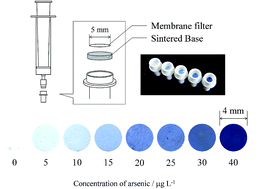Visual colorimetry for determination of trace arsenic in groundwater based on improved molybdenum blue spectrophotometry
Abstract
Sensitive visual colorimetry was proposed for the on-site determination of arsenic in drinking water supplied from groundwater. The method was based on advanced molybdenum blue (MB) colorimetry combined with an enrichment technique using a membrane filter. A portable device equipped with two attachments of a CaCO3-cartridge was used to eliminate interference from phosphate and a tiny membrane holder to retain MB was proposed for on-site analysis. Ten mL of a sample solution containing 0.1–0.4 μg arsenic was passed through the CaCO3-cartridge. The arsenic in the sample solution was converted into MB and collected on a membrane filter as an ion-associate with a cationic surfactant. The arsenic was determined visually from the color intensity of the filter using a color chart made from the standard solution. The sensitivity is sufficient to detect the concentration of 10 μg L−1 adopted by the WHO standard. The speciation analysis of As(III) and As(V) was also successfully performed. The proposed method was applied to several groundwater samples, and the analytical results were well comparable with those obtained by HG-AAS.


 Please wait while we load your content...
Please wait while we load your content...